In July 2021 in Inashiki City, there was a problem that a city employee who had a telephone conversation with a male city council took a leave of absence (after that, he retired on request). Reported the findings at the plenary session of the city council. Power harassment in the remarks of the male city council (The Ministry of Health, Labor and Welfare of Japan said, "Beyond the appropriate scope of work, against the background of superiority in the workplace such as job status and relationships with those who work in the workplace. , Which has been defined in recent years as "an act that causes mental and physical distress or worsens the work environment"), and seems to have concluded that "the telephone had a certain effect on the employee's leave." According to people familiar with the matter, it was a former civil engineering management male employee who took leave. Although the relationship has not been investigated in detail, according to the report, on July 21, 2021, when the two men talked over the phone about the investigation of the water pipes buried in the city, the male city council said, "Everyone's I'll be ashamed in front of you." Employees took leave from the next work day and retired on March 31, 2022 without returning to work. Following the report, the city council passed a resolution recommending resignation to the male city council on June 10 with a majority. A friend of mine is also involved in the administration in other prefectures, but there are many similar cases, and they are just one example. It may also affect pandemics and economic tensions. In addition, while the male city council expressed an apology, the Hyakujo Committee (a special established by the local council based on Article 100 of the Local Autonomy Law to investigate the facts when there are suspicions or scandals regarding the office work of the local government). It is a committee. It has strong investigative authority such as the appearance of related parties, testimony, and the ability to request the submission of records.) I'm not convinced by the contents of. Shipment of "Edosaki Squash", a specialty of Inashiki City, Ibaraki Prefecture, began on May 22, 2022 at the JA Inashiki Central Collection Center in Haga, Ibaraki Prefecture. It seems that the pumpkin was shipped to the market in the metropolitan area after the final confirmation by the members of the JA Edosaki pumpkin subcommittee that produced it. “Edosaki Squash, Produced in Inashiki City, Ibaraki Prefecture and Katsura Town, Ushiku City, it is characterized by its chewy texture and sweetness when harvested at full ripeness. “Edosaki pumpkins” tend to trade at wholesale prices in the market at about twice the price of regular pumpkins. In addition to high quality, market participants appreciate that there is very little variation from producer to producer and from year to year. Good quality means the exquisite feeling of warmth and sweetness unique to ripe pumpkin. In addition, it has a good balance of powder texture and sugar content, and when steamed or cooked in water, it has a texture and sweetness similar to that of butterbur. Then, regarding such quality, the system was set up by assigning inspectors, etc., and this was confirmed, and “Edosaki pumpkin”, which maintained the quality that seems to be ripe with little variation, has been shipped for many years. The cropping type is a combination of semi-forcing (house) cultivation, precocious (tunnel) cultivation, and normal (outdoor) cultivation, and is harvested and shipped from May to August. In addition, it is said that it is harvested and shipped from November to December by controlled cultivation. Since around 1975, we have been working on ripe harvesting ahead of the rest of the country and have implemented thorough quality control such as inspection of all products before shipping. Generally, pumpkins are harvested before they are fully ripe and ripened in storage, but as a general rule, they tend to be harvested about 55 days or more after fruit set. This standard is set based on the results obtained by repeatedly conducting a trial split survey over a period of five years. The appearance of the ripe “Edosaki pumpkin” is a rugged texture with a deeper green color of the pericarp than before the ripeness, and the flesh color is a deep orange color. The harvest standard is set to 55 days or more after fruit set, but if it is likely to reach full maturity early due to the field and weather conditions, we will check the maturity by trial splitting etc. and ship it. With the cooperation of these related organizations, all fields will be visited for each cropping type to investigate the fruit set status, and the growth status will be confirmed and the forecast of harvest time will be managed by visual inspection and palpation. Furthermore, before harvesting, samples are collected from all fields for each cropping type, the maturity is confirmed by trial splitting, and the harvesting / shipping start date is specified for each field to ensure full-ripening harvesting. I am pursuing. The surface layer of the soil in the area where it is produced is widely covered with a volcanic ash layer called the “Kanto loam layer”, which is characterized by high drainage. It has a stable climate with an average annual temperature of 14.1 ° C and annual precipitation of 1,350 mm, and the soil is less likely to become over-dried or over-humidified due to moderate precipitation throughout the year. Therefore, it is suitable for pumpkin production, which is vulnerable to excessive humidity and prefers fields with good drainage. I am afraid of the wisdom of my predecessors. In 1966, production started mainly in the Kimiga Area of Edosaki Town (currently Inashiki City) at that time, and the production area gradually expanded with the passage of years of cultivation, and now it is produced in Inashiki City and Katsura Town, Ushiku City. Producers are proud of the cultivation method and strict management and inspection system cultivated in the history of production for about 50 years, which is the characteristic of “Edosaki pumpkin” with a soft texture and sweetness unique to ripeness. It is protected by continuing to inherit it. On December 22, 2015, Inashiki's Specialty Edozaki Squash, along with “Yubari Melon” in Yubari City, Hokkaido, and “Kobe Beef” and “Tajima Beef” in Hyogo Prefecture, will protect agriculture, forestry and fishery products and foods as a regional brand. It was registered in the Geographical Indication Protection System (GI; Ministry of Agriculture, Forestry and Fisheries). The Geographical Indication Protection System is a new system that protects the interests of producers by registering and guaranteeing the names and characteristics of agricultural, forestry and fishery products that are linked to the region as intellectual property. Seven items have been certified as the first system. In 1982, it was designated as the second prefecture brand production area in Ibaraki prefecture, and all products are thoroughly inspected for quality. Using soil made from compost and unified fertilizer, it is about 10 days longer than normal pumpkin, and again, it is harvested in a fully ripe state for 55 days or more after fruit set, so it is characterized by a soft sweetness. It seems that these strict standards and high quality were evaluated and it was registered as a GI. “Inashiki City” : It is famous as a garden city full of water and greenery, blessed with a rich natural environment and a warm climate, formed by the merger of Edosaki Town, Shintone Town, Sakuragawa Village, and Azuma Town on March 22, 2005. Located in the southern part of the prefecture, there is a rich waterside environment represented by Kasumigaura, Tone River, Shintone River, Ono River, etc. In Kasumigaura, leisure activities such as boating and fishing are popular. In addition, the waterside of Kasumigaura has an environment that serves as a base for fishing, camping, bird watching, etc. such as Cape Wada and Myoki's nose, and Big bean goose; Anser fabalis (Latham, 1787), a nationally designated natural monument that comes to the Inaba area, and Myoki in the Ukishima area. There are many kinds of wild birds such as Ochre-rumped bunting; Emberiza yessoensis (Swinhoe, 1863) that can be seen in the nose. In addition, a relatively large amount of mountain forests such as flatland forests are left on the Inashiki plateau, and together with the natural environment centered on the waterside, it creates a unique and good landscape throughout the four seasons. Therefore, it moisturizes and activates people's lives. Located in the southern part of Ibaraki prefecture, a short distance from Tokyo where production companies are concentrated, a garden city full of water and greenery blessed with a rich natural environment and a warm climate. Blessed with abundant waterside environments such as Kasumigaura, Tone River, Shintone River, and Ono River, it has been the entrance to Hitachi Province on the Tokaido since ancient times and has been a cultural exchange point. Therefore, many historical temples and shrines and temples still exist in the city, and many other valuable cultural assets are scattered in each area, and they are fully equipped with elements that can be used as a stage for movies and the like. That's it. While contributing to the strengthening of the local economy, tourism promotion, and cultural promotion, we are still promoting attractive town development that makes the best use of the rich nature of the hometown and unique culture in cooperation with Ibaraki Prefecture and neighboring municipalities. Since it is located on the border between Hitachi and Shimosa, this area, which has long been an exchange point for both cultures, is dotted with many historical cultural properties. The Hirai family residence, which is a nationally designated important cultural property, was built in the latter half of the 17th century, and the Yokotone Lock; 横利根閘門, which is also a nationally designated important cultural property, is a brick lock that was completed in 1921 and is still in use today. Prefectural designated cultural properties include buildings such as Amidaji Neishakudo and Hosenji Temple(Tendai sect; It is a representative Buddhist temple architecture of the late Edo period, which has been popular as Kannon of Ono for a long time and is counted as one of the 100 best landscapes in Ibaraki and designated as a tangible cultural property of the prefecture. Looking at the history of Hozenji Temple, Hozenji founded the temple with Senju Kannon as its principal image in the 3rd year of the Heian period (828), which is more than a thousand years ago.), and Manganji Bronze Nyorai Statue, and historic sites include Hirohata Shell Mound, a nationally designated historic site. In addition, Osugi Shrine, which is said to have been founded in 767 AD, is crowded with first-time visitors, and "Anbabayashi(磯部, 八幡山, 阿波大杉囃子)" is designated as an intangible folk cultural property. Special agricultural products include “Pumpkin” designated as a brand production area, “Lotus root” designated as a brand promotion production area, and early rice “Milky queen(Rice with an amylose content of around 12%, which has a soft texture and a triple time signature of “taste, stickiness, and gloss.”)”, “Strawberry”, and “Fig”. Taking advantage of the location environment near the metropolitan area, tomato cultivation by institutional horticulture has been actively carried out in recent years. As a tourist facility in the city, there is the agricultural park Potiron Forest, which is said to have about 300,000 visitors annually. Fishing and water sports that take advantage of the blessed waterside environment are also actively practiced. Various events such as fishing tournaments using the Yokotone River, fireworks festivals on the banks of the Ono River, and flower festivals at Wada Park are also held, attracting many tourists. Nine golf courses are located in the hills, which is one of the characteristics of local tourism resources. Ukishima lotus root is the number one lotus root producing area in Japan around Kasumigaura. The lotus root field spreads out in the area as far as the eye can see. Ukishima lotus root has also been shipped to the Tokyo market and has gained overwhelming trust in terms of freshness, quality, and taste. Komorebi Mori no Ibaride is an agricultural park where you can enjoy the nature of the four seasons. In the facility created in the atmosphere of a European country town, you can experience making sausages, butter, bread, milking cows and harvesting vegetables. In addition, there are attractions such as contact with small animals and sheep, horse riding and playset, so you can enjoy the farming experience with your family. He is also focusing on events, and he says he can enjoy various events every month. Country designation : 建造物, 平井家住宅1棟, 柴崎, 個人, 昭51.2.3, Prefecture designation : 建造物, 逢善寺仁王門1棟, 小野, 逢善寺, 昭32.6.26, 国指定 : 建造物, 横利根閘門1構, 西代台地先, 国土交通省, 平12.11.27, 県指定 : 建造物, 逢善寺本堂1棟, 小野, 逢善寺, 昭55.2.28, 県指定 : 建造物, 逢善寺書院/ 庫裡1棟, 小野, 逢善寺, 昭55.2.28, 県指定 : 絵画, 土岐頼英夫人肖像画1幅, 下太田, 智心院, 昭33.3.12, 国指定 : 史跡, 広畑貝塚, 飯出ひろ畑ほか, 稲敷市, 昭57.2.27, 県指定 : 建造物, 厨子1基: 神宮寺, 神宮寺, 昭33.3.12, 県指定 : 彫刻, 釈迦如来立像1躯, 阿波崎, 満願寺, 昭33.3.12, 県指定 : 彫刻, 木造寝釈迦像1躯, 上根本, 阿弥陀寺, 昭33.3.12, 県指定 : 彫刻, 懸仏1面, 高田, 個人, 昭33.7.23, 県指定 : 彫刻, 木造金剛力士立像2躯, 小野, 逢善寺, 昭51.7.5, 県指定 : 彫刻, 木造聖観音菩薩立像1躯: 神宮寺, 神宮寺, 平17.11.25, 県指定 : 工芸品, 五鈷鈴1口, 小野, 逢善寺, 昭32.6.26, 県指定 : 工芸品, 五鈷杵1口, 小野, 逢善寺, 昭32.6.26, 県指定 : 書跡, 妙法蓮華経10巻, 小野, 逢善寺, 昭33.3.12, 県指定 : 有形民俗文化財, 浮島の田下駄一括45足, 浮島, 稲敷市, 昭46.12.2, 県指定 : 史跡, 阿波崎城跡, 阿波崎, 天満神社, 昭10.11.26, 県指定 : 史跡, 神宮寺城跡, 神宮寺ほか, 個人, 昭10.11.26, 国選択 : 無形民俗文化財, あんば囃子, 阿波, あんば囃子保存会, 昭53.1.31. 社会福祉法人筑和会特別養護老人ホーム宝永館他 2013 “湯崎遺跡(寺内)” 稲敷市埋蔵文化財調査報告書10 : 老人ホーム増床工事, 集落, 縄文時代, 遺構なし, 縄文土器(深鉢), 弥生時代, 遺構なし, 弥生土器(壺), 古墳, 竪穴建物7, 土師器(杯, 高杯, 坩, 鉢, 甕, 小型甕), 須恵器(杯, 杯蓋), 土製品(土玉, 支脚), 石製品(剣形模造品, 円板型模造品, 方板形模造品), 銅製品(銅鏃), 鉄製品(槍鉋か鉄滓), 古墳時代, 奈良, 平安, 遺構なし, 須恵器(杯, 杯蓋, ハソウ), 中世(細分不明) 時代, 遺構なし, 瀬戸美濃(天目茶椀), 常滑(捏鉢). Edosaki Squash; Registration number: No. 6, Registered organization: Inashiki Agricultural Cooperative. The appearance is a dark green muscular one. However, once you cook it, you will love it with its chewy texture and delicate sweetness. Pumpkins are produced all over the country, but at this time of year, Inashiki's "Edosaki pumpkin" makes you want to eat it. Pumpkin has a strong image of a supporting role, but this excellent agricultural product definitely has a taste that can be the leading role of this period.
A high-class SQUASH brand that is characterized by its soft texture and moderate sweetness by being fully ripened and harvested.
By cultivating for 55 days or more after fruit set and harvesting after fully ripening, a chewy texture is skillfully realized. The skill that can be done from the craftsmanship is clear.
It has been inherited from its predecessors, and after careful cultivation and trial and error, it has grown into one of the leading brands in Japan, such as being registered in the geographical indication protection system while thoroughly implementing cultivation rules and quality control. However, I hear that the aging of farmers and the shortage of successors are serious.
Edosaki, Inashiki City, located in the southern part of Ibaraki Prefecture, is blessed with watersides such as Kasumigaura and the Tone River, and is a wonderful area that has developed mainly in water transportation and agriculture. It is about 10 days longer than normal pumpkin that is harvested in about 45 days and ripened in the storage, and again, it is harvested in a fully ripe state for 55 days or more after fruit set.
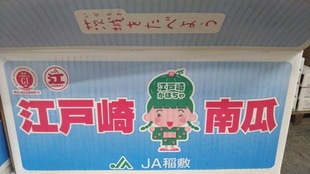
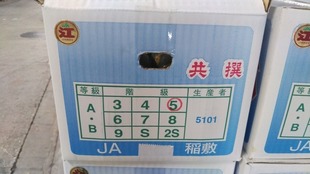
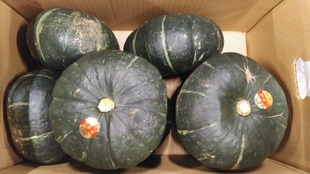
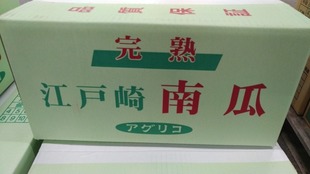
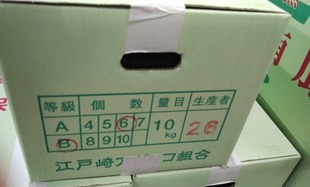
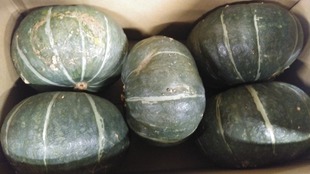



0 件のコメント:
コメントを投稿